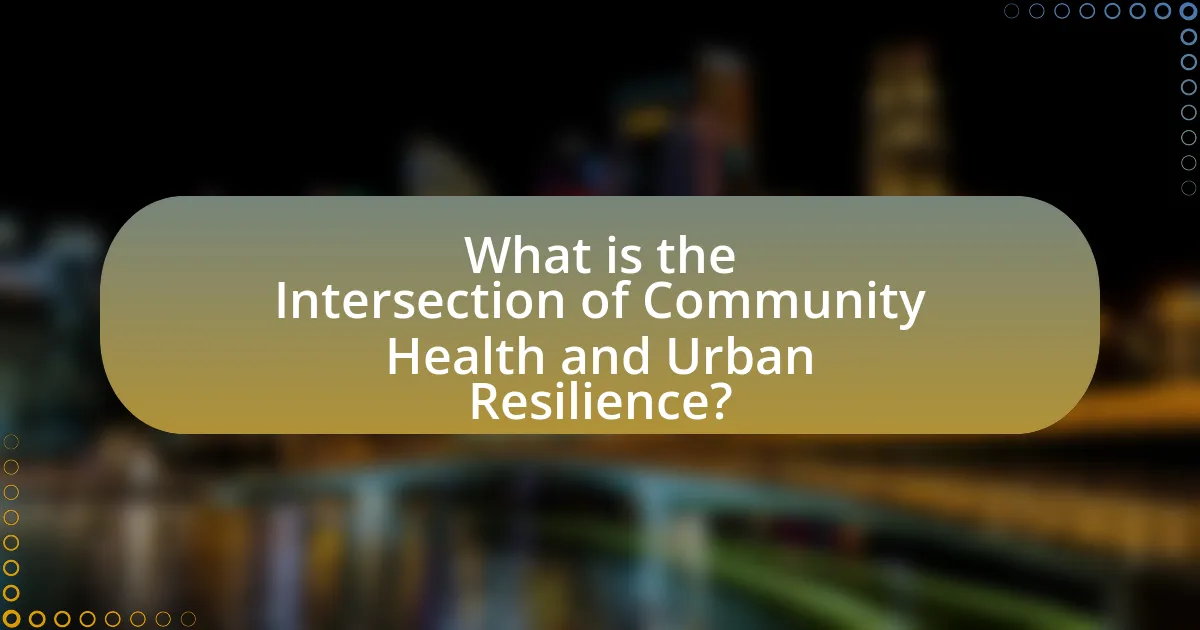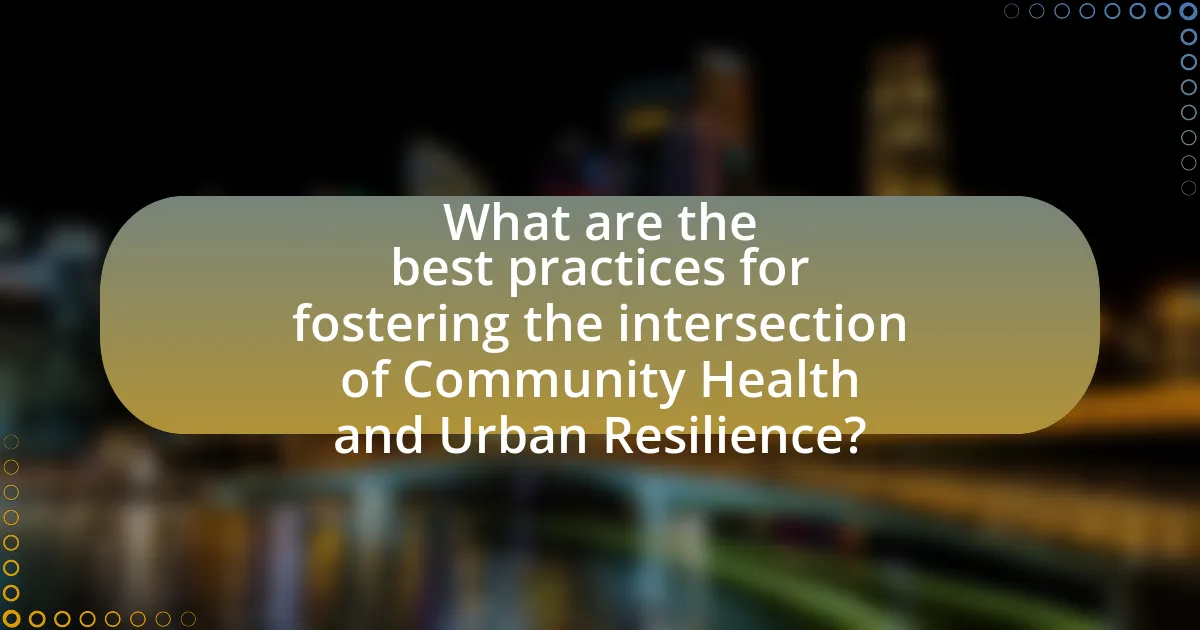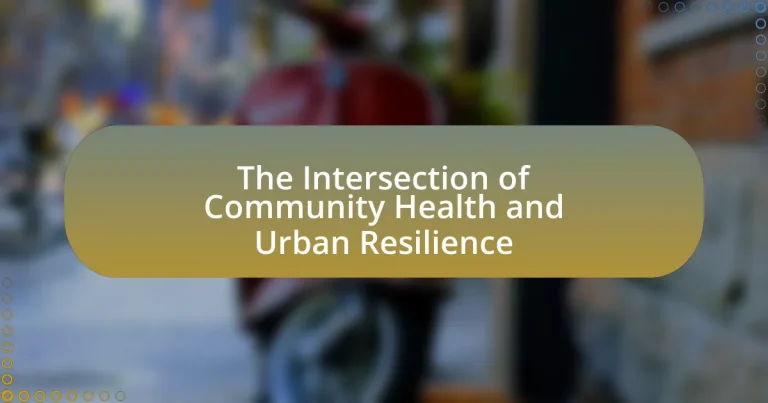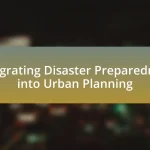The intersection of community health and urban resilience examines how the health of a community affects its ability to endure and recover from various challenges, including environmental, social, and economic crises. Key components of community health include access to healthcare, health education, and social determinants, while urban resilience focuses on the capacity of cities to adapt and recover from disruptions. The article highlights the interconnectedness of these two areas, emphasizing that strong health systems and social networks enhance resilience, ultimately leading to improved health outcomes. It also addresses challenges such as inadequate infrastructure and social inequities, and discusses strategies for integrating health considerations into urban planning to foster sustainable, healthy communities.

What is the Intersection of Community Health and Urban Resilience?
The intersection of community health and urban resilience refers to the ways in which the health of a community influences its ability to withstand and recover from environmental, social, and economic challenges. Community health encompasses factors such as access to healthcare, nutrition, and social support, which directly impact the overall well-being of residents. Urban resilience, on the other hand, involves the capacity of urban areas to adapt to and recover from adverse events, including natural disasters and public health crises.
Research indicates that communities with strong health systems and social networks are better equipped to respond to crises, as evidenced by studies showing that neighborhoods with higher levels of social cohesion experience lower mortality rates during disasters. For example, the Centers for Disease Control and Prevention (CDC) highlights that community engagement in health initiatives can enhance resilience by fostering collaboration and resource sharing. Thus, the synergy between community health and urban resilience is critical for developing sustainable, healthy urban environments.
How do community health and urban resilience relate to each other?
Community health and urban resilience are interconnected as both focus on enhancing the well-being of populations in urban settings while preparing for and recovering from adverse events. Urban resilience refers to the capacity of cities to absorb shocks, adapt to changes, and recover from disruptions, which directly impacts community health by ensuring access to essential services, safe environments, and social support systems during crises. For instance, research indicates that cities with strong social networks and health infrastructure are better equipped to handle public health emergencies, such as pandemics, thereby reducing morbidity and mortality rates. This relationship underscores the importance of integrating health considerations into urban planning and resilience strategies to foster healthier communities.
What are the key components of community health?
The key components of community health include access to healthcare services, health education, environmental health, and social determinants of health. Access to healthcare services ensures that individuals can receive necessary medical care, which is vital for maintaining overall health. Health education empowers community members with knowledge about healthy practices and disease prevention. Environmental health focuses on the impact of the environment on health, including air and water quality. Social determinants of health encompass factors such as socioeconomic status, education, and community support, which significantly influence health outcomes. These components collectively contribute to the well-being of a community and its resilience in facing health challenges.
What factors contribute to urban resilience?
Urban resilience is primarily influenced by social cohesion, infrastructure robustness, environmental sustainability, and effective governance. Social cohesion fosters community networks that enhance collective response to crises, as evidenced by studies showing that neighborhoods with strong social ties recover more quickly from disasters. Infrastructure robustness ensures that essential services remain functional during emergencies; for instance, cities with well-maintained transportation and utility systems can better withstand shocks. Environmental sustainability contributes by reducing vulnerability to climate change impacts, with urban green spaces mitigating heat and flooding. Effective governance, characterized by inclusive decision-making and resource allocation, enables proactive planning and response strategies, as demonstrated by cities that have implemented comprehensive disaster risk reduction policies.
Why is the intersection of community health and urban resilience important?
The intersection of community health and urban resilience is important because it enhances the ability of urban populations to withstand and recover from adverse events while promoting overall well-being. Urban resilience focuses on the capacity of cities to adapt to challenges such as climate change, economic shifts, and public health crises, which directly impacts community health outcomes. For instance, research indicates that resilient urban environments can reduce health disparities by improving access to healthcare, green spaces, and social services, ultimately leading to better health indicators among vulnerable populations. Furthermore, the World Health Organization emphasizes that resilient communities are better equipped to manage health emergencies, thereby reducing morbidity and mortality rates during crises.
How does community health impact urban resilience?
Community health significantly impacts urban resilience by enhancing the capacity of populations to withstand and recover from adverse events. Healthy communities are better equipped to respond to crises, such as natural disasters or public health emergencies, due to lower rates of chronic diseases and improved mental health, which facilitate effective communication and collaboration during emergencies. For instance, research indicates that neighborhoods with higher levels of social cohesion and health resources experience quicker recovery times after disasters, as seen in the aftermath of Hurricane Katrina, where areas with strong community networks demonstrated greater resilience. Thus, the correlation between community health and urban resilience is evident in the ability of communities to mobilize resources, support one another, and maintain functionality in the face of challenges.
What role does urban resilience play in enhancing community health?
Urban resilience plays a critical role in enhancing community health by enabling cities to better withstand and recover from environmental, social, and economic challenges. This resilience fosters improved infrastructure, such as green spaces and efficient public transportation, which directly contributes to physical and mental well-being. For instance, research indicates that access to parks and recreational areas can reduce stress and promote physical activity, leading to lower rates of obesity and related health issues. Additionally, resilient urban planning incorporates disaster preparedness and response strategies, which can mitigate the health impacts of natural disasters, as evidenced by studies showing that communities with robust emergency plans experience fewer health crises during such events.

What challenges exist at the intersection of Community Health and Urban Resilience?
Challenges at the intersection of Community Health and Urban Resilience include inadequate infrastructure, social inequities, and environmental hazards. Inadequate infrastructure, such as limited access to healthcare facilities and poor transportation systems, hampers community health outcomes and resilience efforts. Social inequities, including disparities in income and access to resources, exacerbate health issues and limit the ability of communities to respond effectively to crises. Environmental hazards, such as pollution and climate change impacts, pose significant risks to both health and resilience, leading to increased vulnerability among marginalized populations. These interconnected challenges require integrated approaches to enhance both community health and urban resilience.
What barriers hinder the integration of community health and urban resilience?
Barriers that hinder the integration of community health and urban resilience include fragmented governance, lack of funding, and insufficient data sharing. Fragmented governance complicates collaboration among various stakeholders, leading to disjointed efforts in addressing health and resilience issues. Lack of funding restricts the implementation of comprehensive programs that could enhance both community health and urban resilience. Insufficient data sharing limits the ability to assess needs and measure outcomes effectively, which is crucial for informed decision-making and policy development. These barriers collectively impede the development of cohesive strategies that address the interconnectedness of community health and urban resilience.
How do socioeconomic factors affect community health and urban resilience?
Socioeconomic factors significantly influence community health and urban resilience by determining access to resources, healthcare, and overall living conditions. Communities with higher socioeconomic status typically experience better health outcomes due to increased access to quality healthcare, nutritious food, and safe living environments. For instance, research from the World Health Organization indicates that individuals in lower socioeconomic groups are more likely to suffer from chronic diseases and have limited access to preventive care. Additionally, urban resilience is compromised in economically disadvantaged areas, as these communities often lack the infrastructure and resources necessary to withstand and recover from environmental shocks, such as natural disasters. A study published in the journal “Environmental Science & Policy” highlights that neighborhoods with lower income levels are more vulnerable to climate change impacts, further exacerbating health disparities. Thus, socioeconomic factors are critical in shaping both community health and the capacity of urban areas to adapt and thrive in the face of challenges.
What are the implications of climate change on community health and urban resilience?
Climate change significantly impacts community health and urban resilience by increasing the frequency and severity of extreme weather events, which can lead to health crises and infrastructure challenges. For instance, rising temperatures contribute to heat-related illnesses and exacerbate respiratory conditions due to poor air quality. Additionally, flooding and storms can disrupt healthcare services and displace populations, leading to mental health issues and increased vulnerability among marginalized communities. According to the World Health Organization, climate change is expected to cause an additional 250,000 deaths per year between 2030 and 2050 due to malnutrition, malaria, diarrhea, and heat stress, highlighting the urgent need for urban planning that incorporates climate resilience strategies to protect public health.
How can communities overcome these challenges?
Communities can overcome challenges related to health and urban resilience by fostering collaboration among local stakeholders, including government, businesses, and residents. This collaboration can lead to the development of comprehensive health initiatives and urban planning strategies that address specific community needs. For instance, the World Health Organization emphasizes the importance of community engagement in health promotion, which has been shown to improve health outcomes and resilience in urban settings. By leveraging local resources and knowledge, communities can create tailored solutions that enhance both health and resilience, ultimately leading to sustainable urban environments.
What strategies can be implemented to improve community health in urban areas?
Implementing strategies such as enhancing access to healthcare services, promoting healthy lifestyles, and fostering community engagement can significantly improve community health in urban areas. Access to healthcare services can be improved by increasing the number of clinics and healthcare providers in underserved neighborhoods, which has been shown to reduce health disparities. Promoting healthy lifestyles involves creating safe spaces for physical activity, such as parks and recreational facilities, which can lead to increased physical activity levels among residents. Community engagement initiatives, such as health education programs and local health fairs, empower residents to take charge of their health, leading to better health outcomes. Studies indicate that urban areas with strong community health initiatives experience lower rates of chronic diseases and improved overall well-being.
How can urban planning enhance resilience and health outcomes?
Urban planning can enhance resilience and health outcomes by integrating green spaces, promoting mixed-use developments, and ensuring equitable access to resources. Research indicates that urban green spaces improve mental health and physical well-being, with a study published in the journal “Environmental Science & Technology” showing that access to parks can reduce stress and increase physical activity levels. Additionally, mixed-use developments foster community interaction and reduce reliance on automobiles, leading to lower air pollution and improved public health. Furthermore, equitable access to healthcare facilities and healthy food options in urban designs can address health disparities, as highlighted by the World Health Organization’s report on urban health. These strategies collectively contribute to building resilient communities that prioritize health and well-being.

What are the best practices for fostering the intersection of Community Health and Urban Resilience?
The best practices for fostering the intersection of Community Health and Urban Resilience include integrating health considerations into urban planning, promoting community engagement, and enhancing access to green spaces. Integrating health into urban planning ensures that infrastructure supports physical and mental well-being, as evidenced by studies showing that walkable neighborhoods reduce obesity rates and improve mental health outcomes. Promoting community engagement allows residents to participate in decision-making processes, which has been linked to increased social cohesion and better health outcomes. Enhancing access to green spaces is crucial, as research indicates that urban greenery can reduce stress and improve overall community health. These practices collectively contribute to resilient urban environments that prioritize the health of their inhabitants.
What successful models exist for integrating community health and urban resilience?
Successful models for integrating community health and urban resilience include the Healthy Cities initiative and the Resilient Cities framework. The Healthy Cities initiative, launched by the World Health Organization, promotes health through urban planning and community engagement, resulting in improved public health outcomes and enhanced community resilience. The Resilient Cities framework, developed by the Rockefeller Foundation, focuses on building urban resilience by addressing social, economic, and environmental challenges, which in turn supports community health by fostering equitable access to resources and services. Both models demonstrate that integrating health considerations into urban planning leads to sustainable and resilient communities, as evidenced by case studies in cities like Barcelona and New Orleans, where these approaches have successfully reduced health disparities and improved overall community well-being.
How have specific cities successfully combined these two areas?
Cities like Copenhagen and Melbourne have successfully combined community health and urban resilience through integrated urban planning and public health initiatives. Copenhagen has implemented extensive cycling infrastructure and green spaces, promoting physical activity and reducing pollution, which enhances community health while increasing urban resilience against climate change. Similarly, Melbourne’s urban forest strategy aims to increase tree canopy cover, improving air quality and providing shade, which supports public health and mitigates heat effects during extreme weather events. These strategies demonstrate a clear link between urban design and health outcomes, showcasing effective models for other cities to follow.
What lessons can be learned from these successful models?
Successful models in the intersection of community health and urban resilience demonstrate the importance of integrated approaches that prioritize collaboration among stakeholders. These models emphasize the need for community engagement, as active participation leads to tailored solutions that address specific health challenges. For instance, the Healthy Cities initiative has shown that involving local populations in decision-making processes enhances the effectiveness of health interventions. Additionally, data-driven strategies, such as those employed in the Resilient Cities framework, highlight the significance of using evidence to inform policies and practices, ensuring that resources are allocated efficiently to meet community needs. These lessons underscore the value of adaptability and responsiveness in urban planning, which are crucial for fostering sustainable health outcomes in diverse urban environments.
What practical steps can communities take to enhance both health and resilience?
Communities can enhance both health and resilience by implementing integrated health programs, promoting active transportation, and fostering social cohesion. Integrated health programs, such as community health clinics, provide accessible healthcare services, which improve overall health outcomes. Promoting active transportation, like walking and cycling, not only encourages physical activity but also reduces pollution, contributing to better air quality and health. Fostering social cohesion through community events and support networks strengthens relationships among residents, which is crucial during crises, as studies show that connected communities recover faster from disasters.
How can community engagement improve health and resilience initiatives?
Community engagement can significantly enhance health and resilience initiatives by fostering collaboration, increasing trust, and ensuring that programs are tailored to the specific needs of the community. Engaged communities are more likely to participate in health programs, leading to higher rates of vaccination, preventive care, and health education. For instance, a study published in the American Journal of Public Health found that community-driven health initiatives resulted in a 25% increase in vaccination rates in underserved populations. Additionally, community engagement helps identify local resources and strengths, which can be leveraged to build resilience against health crises, as evidenced by the successful implementation of community-led disaster preparedness programs in various urban areas.
What role does policy play in supporting community health and urban resilience?
Policy plays a crucial role in supporting community health and urban resilience by establishing frameworks that promote equitable access to healthcare, environmental sustainability, and disaster preparedness. Effective policies can enhance community health by ensuring that resources are allocated to preventive care, mental health services, and health education, which are essential for building resilient populations. For instance, the World Health Organization emphasizes that policies addressing social determinants of health, such as housing and transportation, directly impact community well-being and resilience. Furthermore, urban planning policies that incorporate green spaces and infrastructure improvements can mitigate the effects of climate change, thereby enhancing urban resilience. Studies show that cities with comprehensive health and resilience policies are better equipped to respond to public health crises and environmental challenges, demonstrating the significant impact of policy on both community health and urban resilience.


